Although the earliest history of polo is relatively obscure, evidence of the game reaches back more than two thousand years to the east and middle eastern region and is claimed to have been first played in China, India and Iran. Colloquially known as "the sport of Kings," the game was first introduced in the 1870s in the U.S. on the East Coast, primarily in New York and in Newport, Rhode Island. The first mention of Chicago polo that I found dates back to 1879 in a game played in Lincoln Park on October 18. The article gives some background on this new sport and tells of the city's newest, and ultimatel short-lived sports team: For the benefit of the ignorant, polo may be described as shinney on horseback, or, rather, ponyback. The "young bloods" - let us give them that title, although it may safely be said that few of them will ever see the fortieth year again - meet twice a week on the green turf at the south end of Lincoln Park, and they perform equestrian feats which would warm the cockles of Barnum's heart. The steeds are borrowed from an adjoining stable. They are commonly known as "plugs," and their conspicuous feature is angularity, with a chronic disposition to lie down under the weight on top. The "Club" met yesterday afternoon to the number of four. The four in the middle of the open space provided for them looked as small as flies in a large barrel of molasses, and about as helpless. Society is grateful to them for the introduction of this favorite pastime of the upper ten, and society appeared on the grounds in several carriages fitted with young and enthusiastic ladies, who tried with many marks of approbation to stimulate the young fellows in their manly work. It was no use, however. For a long time the four trotted backwards and forwards after a ball which they tried to strike with a long stick, and which they missed every time with astonishing regularity. Sometimes they came whack on the ground, nearly dislocating their wrists. The ponies' feed had a hard time of it; but they generally retaliated in elevating their hind quarters and sending a cold shudder through the spectators at the imminent risk run. When they were not hammering at the feet of the animals or at the turf, they dashed vigorously at the legs of one another. There is not another mention of polo in Chicago until the 1880s when throughout that decade the sport was played on roller skates at the indoor skating rink at the corner of Michigan Avenue and Congress Street. Then in the summer of 1890, water polo was introduced to the city of Chicago. Chicago Daily Tribune, June 22, 1890:  Finally, fifteen years after its inauspicious Lincoln Park debut, the Chicago Polo Club was established. Chicago Daily Tribune, May 20, 1894: 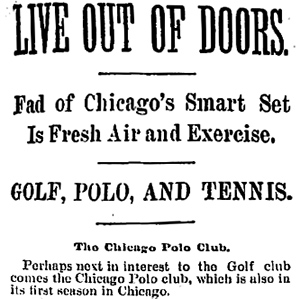 Chicago Daily Tribune, June 7, 1894: 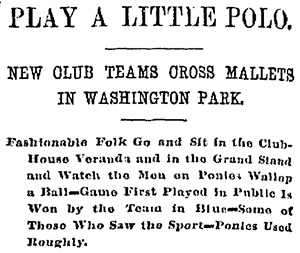 Excerpt from a December 3, 1949 newspaper article about polo at the Chicago Avenue Armory: Tonight - and we hope on many more Saturday nights to come - we'll ba a member of that agog audience howling itself hoarse over horses at the indoor polo matches in the Chicago avenue armory. Today this slightly refined and highly murderous pastime of shinny-on-horse-back packs packs the galleries to witness a show that combines the racier aspects of Ben Hur, Tia Juana, Custer's last stand, and a Donnybrook fair. Polo, gentle readers, has no gentle riders! A review of Chicago's indoor polo players of 15 and 20 years ago is a cross section of out town's blue book of commerce and industry. There are about 100 indoor players in Chicago this season, riding under roofs at the armory, the Plush Horse stables, the Parkway stables and the North Shore Polo club. |
Even today there are many people who remember attending polo games and other events at the Chicago Avenue Armory. Beginning in 1949 when the Illinois National Guard organized an indoor league, and continuing through the mid-1980s - with a ten year break between 1966 and 1976 - the public streamed into the armory's 4000-seat arena to enjoy "the sport of Kings."
1952 advertisement for arena polo at the Chicago Avenue Armory 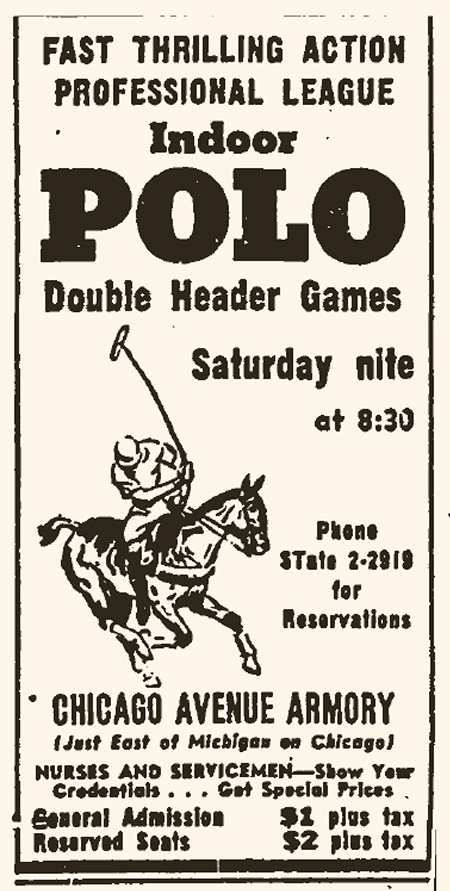 Polo was used for training cavalrymen since its earliest days, so when the sport arrived in Chicago, the First Illinois Cavalry, Illinois National Guard was among the first to play as a team. Since the National Guard's monetary allotment fell short of the costs of caring for horses and maintaining their stables, the First Cavalry first raised money by staging polo matches. Polo was introduced at the Chicago Avenue Armory as soon as the building's first addition was completed in 1925. The original First Illinois Cavalry, the regiment that had been converted to a field artillery unit for the First World War, were the first to stage games in the armory's arena: Chicago Daily Tribune, April 4, 1925: 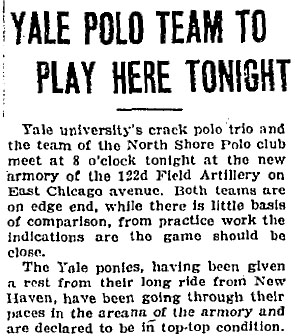 June 10, 1925  At this point, even before the Black Horse Troop was formed (1929) and Paul Butler became its commander, his Oak Brook polo grounds was a popular venue for the sport. The polo league included independent and military teams. Polo was an Olympic sport from 1900 through 1936. In 1929, during that early heyday, the Chicago Black Horse Troop was formed as the ceremonial unit of the reconstituted 106th Cavalry. The Black Horse Troop often played polo against the 122nd Field Artillery and other teams in the Chicago Polo Club. December 18, 1947 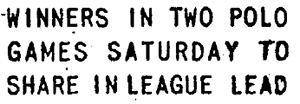 In 1940, the Black Horse Troop addition to the armory opened, and in 1949, the Chicago Avenue Armory became the site for regularly scheduled arena polo games. October 19, 1949: 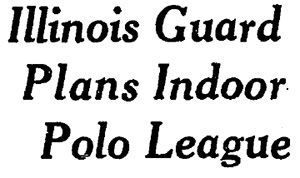 Excerpts: Plans for an indoor polo league to be sponsored by the Illinois National Guard with the entire program to be directed by Guard personnel, were prepared last night by the Guard's six man polo committee, of which Grig. Gen. Robert Moffet is chairman. Practice will start Nov. 3 in the Chicago av. armory, where two games will be played each Saturday night from Nov. 26 to April 1, with proceeds going to the Guard's athletic and recreation fund. Invitations have been extended to polo clubs in the Chicago area, Milwaukee, and Detroit, and to Chicagoland schools and academies sponsoring teams, to enroll as league members. The Guard will be assisted by a civilian polo advisory committee made up of John E. Ivory St., Paul Butler, Pat Connors, James H. Hannah Sr., Tom Healy and Truman Wood. January 5, 1977:  After a ten year hiatus, the formation of the new Polo Club of Chicago re-activated polo in the Chicago Avenue Armory. Excerpts from article by Rick Talley: The sport obviously was made for the Chicago Avenue Armory, that mysterious, anonymous arena located just off Michigan Avenue, across the street from Eli's watering hole. The spectators? They come in all shapes and sizes - Near North types on Saturday night dates, families from the suburbs, retired generals wondering why all the commotion in the old armory. By 1982, after Governor James Thompson had already suggested that the state would be selling the Chicago Avenue Armory, polo continued in the armory's arena. On January 29, under the headline, "A Flash of Fashion, and a Dash of Danger," reporter Steven Morris wrote: In a drafty concrete hallway, large and muscular horses stood with their grooms, waiting to take the place of animals that, hot and steaming from exertion, would be led off the field to be washed, dried and rested in stalls underground. Upstairs most of the 4,000 seats that surround the oval polo field were filled. Some spectators wore jeans, others expensive suits and fur coats. Some munched on potato chips and Polish sausage from the concession stand; others opened wicker picnic baskets containing chicken, caviar, cheesecakes. A few yards from where riders crowded their four-foot mallets amid a blur of horses' legs, one group dipped brerad into a bubbling foundue pot and another sipped wine and ate cold pasta and liver pate. Polo matches were held at 7pm on Saturdays through the winter until April. General admission in 1982 was $3.25; box seats were $5.25. July 29, 1982:  1982 would turn out to be the Chicago Avenue Armory's last polo season. In this article written by Dori Meinert, she reports: The Polo Club of Chicago has been given until Monday to remove members' horses, which have been stabled in the drill floor area of the armory for almost seven years. The guard didn't renew the polo club's annual contract when it expired in April. Lorens Tronet, a spokesman for the group, said it plans to hold several protests of the guard's action. Community protest has stalled several attempts by the state in recent years to sell the two-block-long armory. Other organizations that regularly use the armory include Kid Sports Inc., Friends of Handicapped Riders and Grand Slam Jumping, which sponsors horse contests. Conversations around the Chicago Avenue Armory's demise continued for several more years until in 1987, the Museum of Contemporary Art secured the site for their new building. |